Motorola Razr review: A fashion statement, not a flagship
Can a sleek design justify a $1,500 investment?
The Motorola Razr is many things. It's one of the first foldable phones you can buy right now. It's a feat of engineering from a storied mobile brand. It's a Verizon exclusive. (Sigh.) What the Razr absolutely isn't, though, is practical.
For some of you reading this, that's not going to be an issue. The Razr is as style-forward as the classic model that came before it, and maybe that's enough. But Motorola and Verizon are asking people to pay $1,500 for this thing — a certain degree of practicality is a must. At the risk of immediately spoiling the rest of this review, the Razr won't run faster, last longer or take better pictures than literally any other phone in this price range. It's a fashion statement, not a flagship.
Like I said, maybe that's enough for some. But for everyone else, for people who are more likely than ever to hold on to their smartphone for years, is a compromised phone like the Razr really worth the splurge? I think we both know the answer to that.
A classic-ish design
When I first talked to Motorola engineers about the Razr last year, they were clear about one thing: They didn't specifically set out to reinvent the Razr. Instead, internal research suggested that people really just preferred the idea of a regular smartphone that folded in half for easy storage over something more Galaxy Fold-y. The rest was just nostalgic kismet.
Motorola didn't adopt that retro design whole cloth, though. This new Razr is considerably more square than the classic it drew inspiration from, and the hinge is stiff enough that you can't flip it open with the same panache. It has a big, touch-sensitive external display and a grippy back to help you hang on to the thing. Oh, and it's surprisingly heavy, too. Needless to say, this definitely isn't the Razr you (or your parents?) might remember. Based on the attention the Razr has gotten from people around me this week, though, a phone that just flips shut like this when you're done still has wide appeal. But has this mostly classic design really held up after 10 years? Well, yes and no.
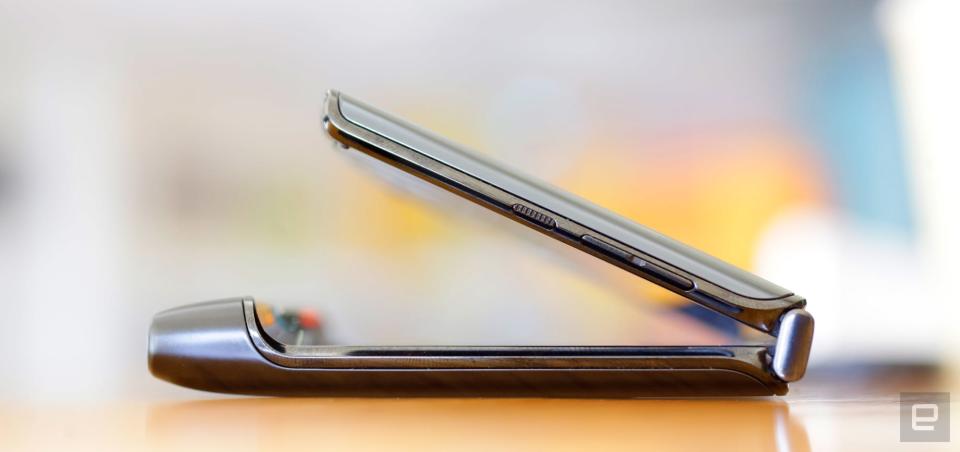
The Razr cuts a sleek figure when it's open — it's 6.9mm thick, about the same as the Galaxy Fold — but that trim look meant Motorola had to make some interesting design decisions. For one, Motorola skipped out on the traditional SIM slot entirely. Instead, the Razr is the first phone I've ever tested that relies solely on a virtual eSIM. That's not inherently a bad thing, but it does mean you can't switch your Verizon service to another device with a simple SIM swap. There was no room for a microSD card slot either, so you'll have to make the 128GB of onboard storage last.
And then there's the Razr's chin, which is far more controversial now than it used to be. In fairness, it serves an important purpose: Motorola squeezed the main speaker and fingerprint sensor in there, and it provides extra space for the bottom edge of the screen to slide into when you close the phone. I like the chin more than most do, because it means the on-screen navigation keys naturally sit a little closer to my thumbs, but when you factor in the phone's tall, narrow design, it means your hands will have to do a lot of shimmying to reach the top of the display. The chin also has some sharp edges, which sometimes make the Razr uncomfortable to hold when you're taking photos or (gasp) talking on the phone.
The original Razr had some very small volume buttons, and this one does, too. They're wedged into the phone's top half along the right side, next to a narrow textured power button. Using these buttons with any sort of regularity is going to get frustrating because they all feel pretty indistinct — they're difficult to find when you're blindly searching for them, and you're almost certainly going to mix them up.
You may have also heard about the subtle creaking noise the Razr makes when you open and close it. It's honestly not a big deal; it's only really noticeable in quiet rooms, and Motorola says it's a perfectly natural consequence of using such a complex hinge design. It's not great to hear what sounds like a discreet fart coming from a $1,500 phone, but there's more going on here than just some odd sounds.
A phone's hinge might not seem particularly interesting, but now that foldables are a thing, it might be the single most important element a phone-maker has to nail. Motorola's engineers went through 26 iterations to get the feel and stability just right, and I'd say they did a great job. The hinge is tighter than you might expect, so opening the phone with one hand requires practice, and yes, that means your thumbnail will dig into that big, flexible screen inside. So far it hasn't been an issue, and there is something immensely satisfying about opening the Razr. Motorola gets credit for that, at least.
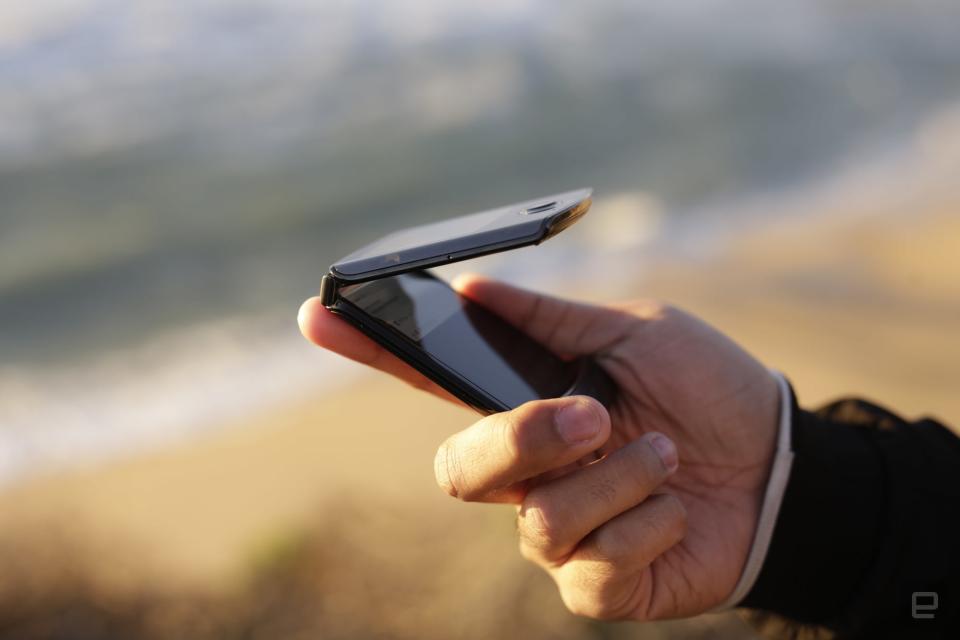
Having this many moving parts means the Razr can't be nearly as durable as a more conventional slab smartphone. Part of that is down to normal wear — after just a week, the hinge feels slightly looser than it did on day one — but the rest of it is more fundamental. For example, the Razr doesn't have an IP rating for water or dust resistance, because this hinge and screen configuration means something could potentially get inside and muck things up. The best Motorola could do here is give the Razr a water-repellent nano-coating meant to protect your $1,500 investment from stray raindrops. And since I have to return this phone to Motorola very soon, its long-term durability isn't something I can vouch for.
There is one more tidbit from those early conversations that has stuck with me since then: Motorola repeatedly referred to the phone as a premium, "design-first" device, but specifically not a "flagship" phone. That goes a long way in explaining the many compromises Motorola had to make here, but this distinction still doesn't feel right to me.
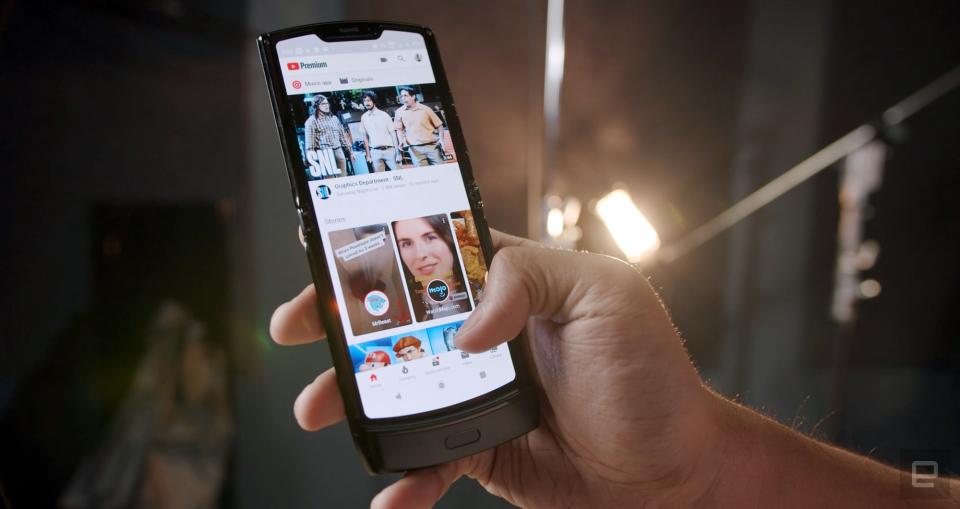
Two displays, even more compromise
Once you've gotten over the novelty of opening and closing a smartphone in 2020, it's time to come to grips with its screens. The Razr has two of them, and while Motorola has cooked up some ways to get things done when the phone is closed, you're going to spend most of your time with the flexible, 6.2-inch OLED screen inside.
Before seeing the Razr for the first time, I was a little apprehensive — after all, Motorola isn't exactly known for peerless smartphone displays. But at least some of those concerns were unwarranted. The colors are surprisingly vivid right out of the box, and its viewing angles are pretty generous, too — you can peer in from off to the side and still see everything perfectly. Motorola went with a 21:9 display, which really just means the screen is taller and narrower than other smartphones you've used. This turned out to be equal parts blessing and curse: Motorola's screen choice means the Razr is very easy to hold in one hand, but it also means some things, like the on-screen keyboard, feel cramped.
If this were a more traditional smartphone, I'd be inclined to say this is meant to feel more cinematic — most movies are shot in 21:9, after all. I can't say that this time because the Razr's screen runs at a surprisingly low resolution: 876 x 2,142. In other words, this is far from the crispest, prettiest display you'll see this year. You can't even watch YouTube videos at anything higher than 720p. I will say, though, that this all sounds a little worse than it actually looks. In fact, because I spent most of my time using the Razr at a reasonable distance (as in, my nose wasn't pressed up against the plastic) the dip in resolution often went unnoticed.
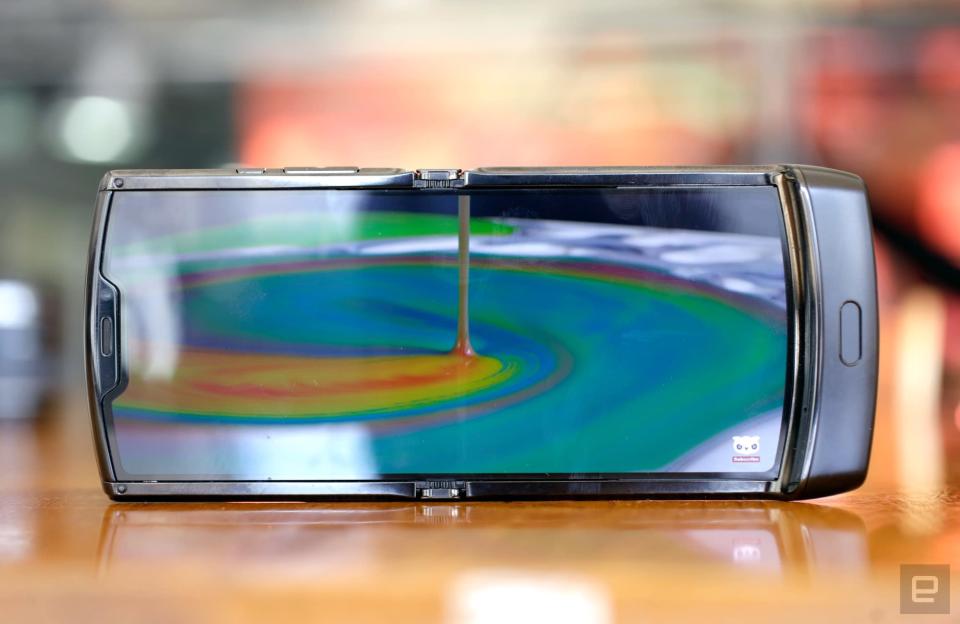
Speaking of things I just didn't notice after a while, there are two very subtle creases above and below where the hinge actually lives. You're more likely to feel them (plus a few other very shallow divots) than see them under the relatively soft plastic screen layer. Motorola says these sorts of lumps are normal, but they're still far from ideal, considering just how much they're charging. And beyond that, there are bigger things here to be concerned about.
For one: The screen is much dimmer than what you'd find on other phones in this price range. Using this thing outdoors can feel like a struggle sometimes. Under certain kinds of bright light, the screen also takes on a splotchy, almost oily look because of the anti-scratch coating Motorola used. It in no way impacts the screen's usability, it's just kind of ... ugly. And even though this internal screen mostly sits flush with the bezels around it, the panel on my review unit feels slightly raised on the left side, right near the hinge. Whenever I have to tap something over there, I can actually feel the plastic panel moving up and down when I apply pressure. Could this somehow impact the screen's usability over time? I was very skeptical, but for what it's worth, Motorola provided this statement:
"What you're noticing can be attributed to the movement of the display into the chin. The razr's dynamic clamshell folding system is comprised of several moving parts including: a flexible OLED display module, metal support plates and a state-of-the-art hinge system. The display moves into the chin slightly when folded and pulls out to keep it in tension when open. This in no way affects the quality of the product."
For now, though, the Razr's screen has put up with my everyday punishment without issue. I've accidentally dropped the phone facedown a few times and the display still seems fine. It also survived a trip to the beach on a windy day when sand was whipping around like crazy, but I don't know how often I'd want to press my luck like that. See, every time you close the phone, the screen directly above the hinge subtly and momentarily lifts away from the Razr's body. It's not hard to imagine some foreign junk — like that pesky, high-speed sand — could find its way inside and wreak havoc. That gap is only ever open for a split second, so it may well never be a problem, but I still can't help but quietly worry.

Foldables like the Razr are most vulnerable when they're open, so it's not a huge surprise to see Motorola stick a 2.7-inch touchscreen on the outside of the phone. It's mostly there to let you handle very quick tasks, like checking your notifications, by long-pressing app icons and sending canned responses to messages, but you can also use it to frame up selfies and toggle a few customizable settings like WiFi and Bluetooth. Even better, if you're looking at a notification from an app — for me, that most often means Gmail or Telegram — you can open the Razr to immediately pick up where you left off.
For these kinds of little things, the Quick View display is usually enough. But, I can't help wishing Motorola did more with it. I'd love to be able to whip out the Razr while it's closed and see Google Maps directions to a restaurant or shortcuts to control my apartment's Hue lights. (The Galaxy Fold's external display is far from ideal, but at least you can use it for standard smartphone things.) Motorola says that it's carefully evaluating what apps might work best on a small screen like this one, so maybe we'll see it become more useful over time. In the meantime, Motorola really needs to make the Razr's external screen easier to unlock. Theoretically, all it requires is an upward swipe, but I have never, ever been able to get this simple gesture right on the first try.
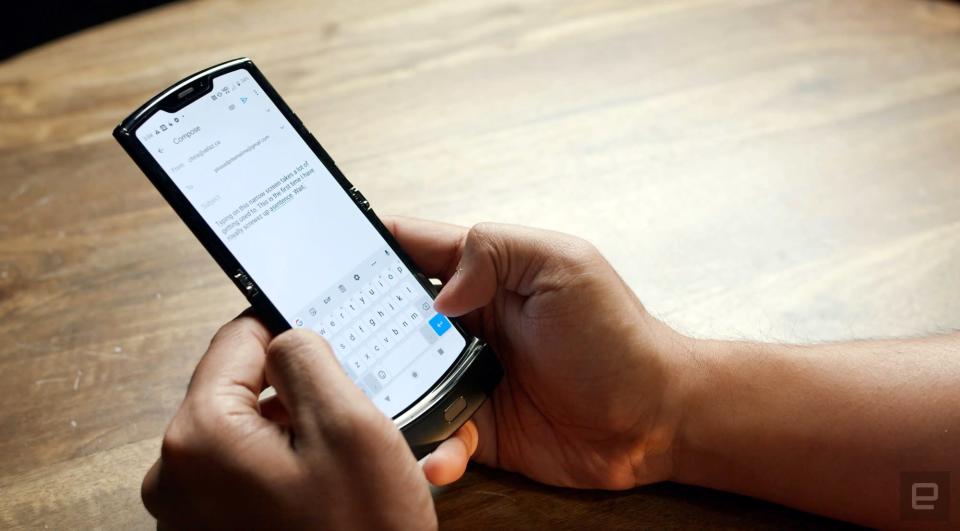
In use
So far, this review feels bleak, but there is at least one semi-silver lining: The Razr actually runs pretty well, relatively speaking. The Snapdragon 710 chipset and 6GB of RAM Motorola chose certainly don't offer flagship levels of performance, but at this point, expecting flagship-caliber anything is unrealistic. Still, the Razr has enough power to handle most parts of a person's daily grind without issue — you'll notice some slight stuttering when you're playing more demanding games like Asphalt 9, but when it comes to standard daily use, I never felt like I was hugely behind the curve.
Part of what helps the Razr run as fast as it does is Motorola's clean software. Well, clean-ish; there's a ton of Verizon bloatware pre-installed. Beyond that, there isn't much cruft here to bog down performance. Instead of the usual manufacturer-made email, messaging and web browser apps, you get the stock Google equivalents. Motorola's classic actions are back, so you can karate chop while holding the phone to fire up the flashlight or give it the ol' double-wrist-twist to launch the camera. I'd exercise some caution when trying to pull off the latter trick, though: The Razr's top half tended to flop around a bit, which is not reassuring.
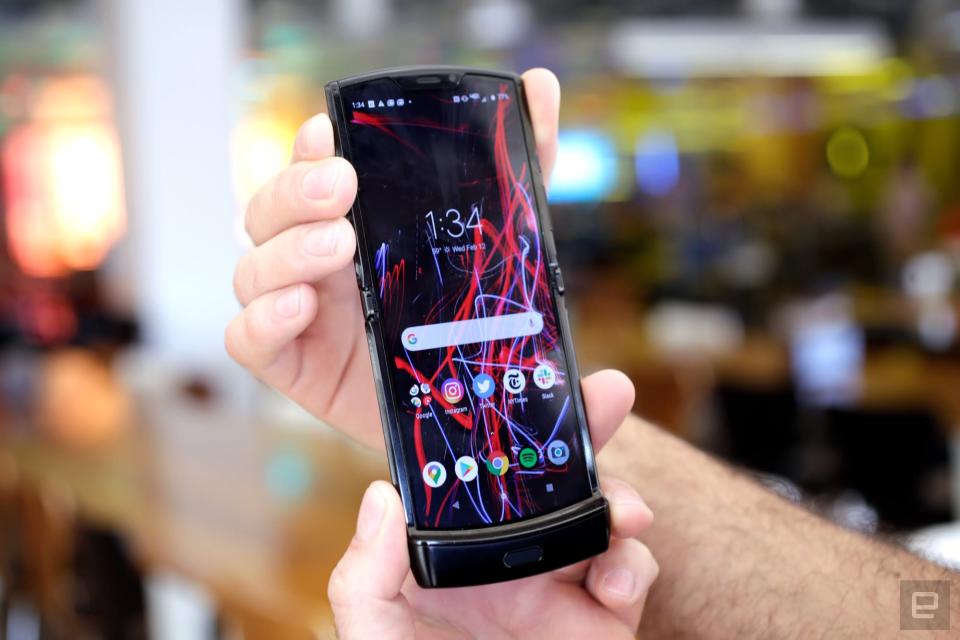
There are a few more things to note about the Razr's software. Unlike most other premium phones you're likely to see in 2020 — including the new Galaxy Z Flip — the Razr only runs Android 9.0 Pie. Now, that's a fine flavor of Android, but Motorola could've done better. Oh, and for you retro fanboys, there's a classic Razr mode you can access from the Quick Settings panel — once enabled, it swaps the stock launcher out for a nearly pixel-perfect recreation of the original RAZR V3, right down to the jaunty boot chime and laser-etched keypad. It's a total gimmick and not meant to be used seriously, but whatever, it's a fun nod to a device this new Razr owes so much to.
More than anything, though, I was concerned about power management and battery life. How could I not be? The best Motorola could do is squeeze in two slim, discrete batteries with a combined capacity of about 2,510mAh — that's far less than any other smartphone I've tested in the last year. (Even more troubling, a recent YouTube teardown suggests the actual combined battery capacity is closer to 2,400mAh.)
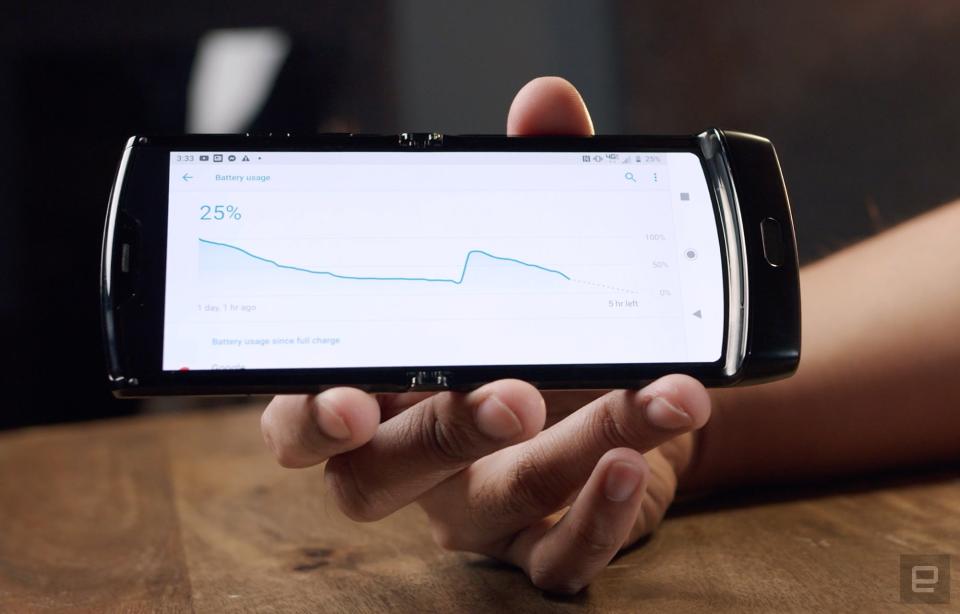
Thankfully, the reality wasn't quite as bad as I expected. If you play your cards right and don't use the phone constantly, the Razr could feasibly last for about 12 hours; I've gotten pretty close a few times. Things get a little dicier when we start talking about sustained use. If you're the kind of person who sits around scrolling through Instagram for hours on end, you'll probably want to keep the included 18W TurboCharger handy. The Razr's screen-on time maxes out at around four hours. Plus, it gets pretty warm, pretty quickly. (I suspect that's because there's so little room inside for proper heat management, but Motorola wouldn't say so on the record.)
If this were another review, these slightly underwhelming results wouldn't feel so distressing. Again, you're being offered a level of performance and battery life that is at best just adequate, but a $1,500 phone should be able to do at least a little better, right?
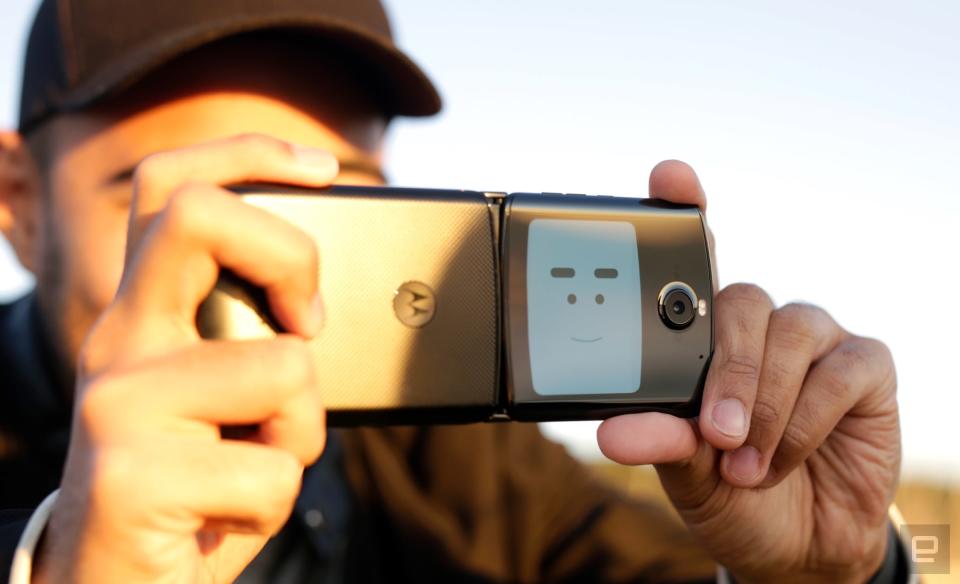
Lackluster cameras
Smartphone-makers left and right are embracing high-resolution camera sensors and ambitious multi-camera setups because they know people really give a damn about taking photos. Motorola gets this. I know, because if you look at the brand's affordable One-series smartphones, many of them have — you guessed it — high-resolution camera sensors and ambitious multi-camera setups. And what do we get with the Razr? A single main 16-megapixel camera with an f/1.7 aperture and a 5-megapixel front-facing camera in a notch cut into the screen.
In fairness to Motorola, that main camera isn't bad — I've taken quite a few photos that actually came out pretty nicely, even if it's mostly because San Francisco is very good-looking. (I even threw a few of them into our Samsung Galaxy Unpacked liveblog.) It's just that the camera is mediocre compared to everything else in this price range.
The Razr's photos are usually lacking in the dynamic range department, and exposure can be inconsistent. (Sunny skies almost always look a little off, for instance.) Still, when the conditions are right, you'll find decently saturated colors and, if you're very lucky, ample detail.
I should emphasize that this faint praise only applies when you're in a well-lit environment — in anything less, your photos are going to start to get rough. Expect your results to be even softer and less satisfying with an extra dose of shutter delay because the camera has some serious trouble focusing in the dark. Night Mode is a necessity in those situations, but photos taken with it look considerably worse than those taken on an iPhone 11 Pro or Pixel 4 XL, two premium phones that cost hundreds less than the Razr.
Oh, and about that front-facing camera: The best thing I can say is that it exists. I have to assume Motorola squeezed one in here mainly for video calls, because you'd be kidding yourself if you expected quality selfies out of this thing — just use the main camera while the Razr is closed for much better results. Honestly, do yourself a favor and avoid this camera when you can.
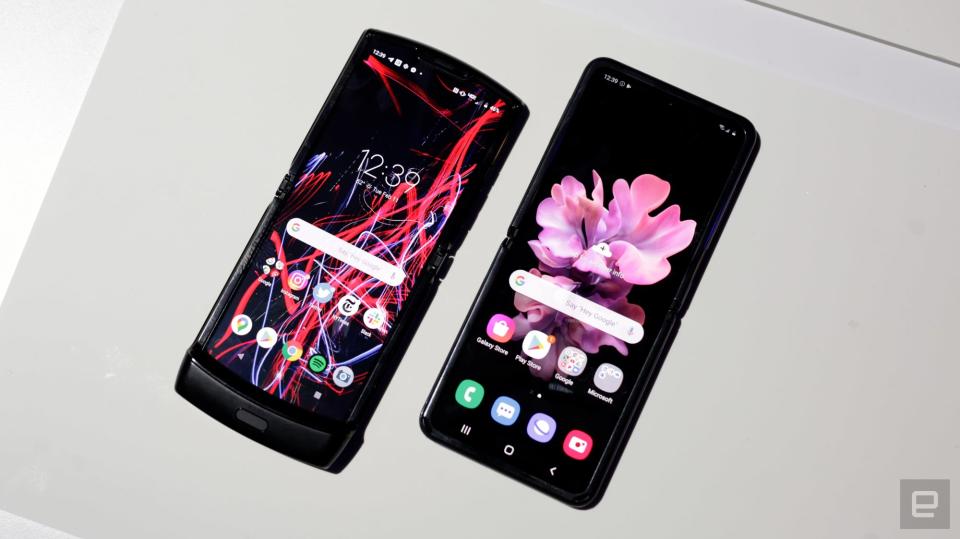
The competition
Not all foldables are created equal, so even though a few are on the market, the Razr only really has one direct competitor: Samsung's new, $1,380 Galaxy Z Flip.
You might have noticed I've only mentioned the Z Flip once in this review. That wasn't an oversight; based on everything we've seen and experienced so far, the Z Flip is a more powerful, more capable take on the foldable flip phone concept, and it costs a little bit less. It is, based on everything we've seen and experienced so far, the better option for damn near anyone. The reason I didn't mention it much here is because, well, even if the Razr was the only smartphone of its kind on the market, it still wouldn't be worth the splurge for anyone but the profoundly style-obsessed.
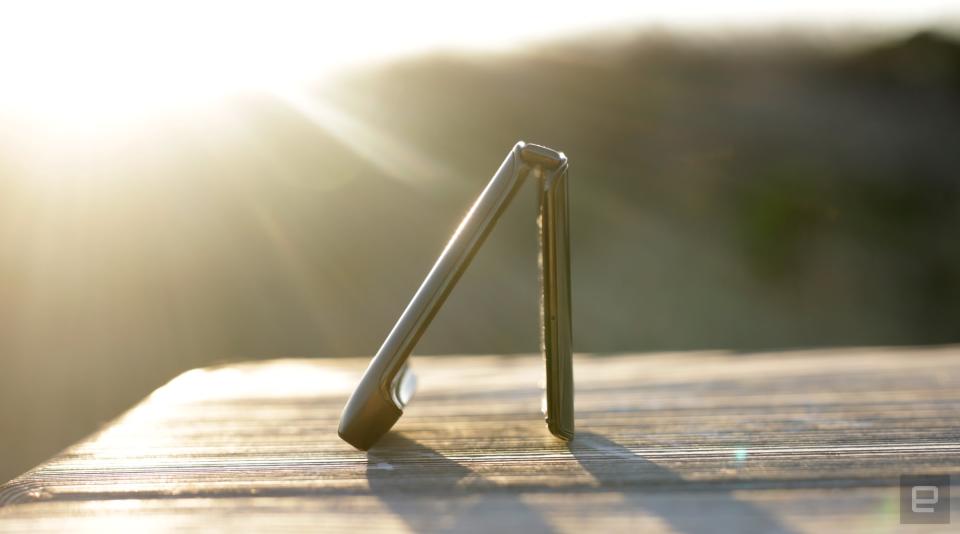
Wrap-up
If, after all this, you find yourself still wondering whether a Razr should be your next phone, I invite you to take part in a little thought experiment I just cooked up. Please, take a moment to consider the following statement: "In terms of performance and experience, the 2020 Motorola Razr is a $400 smartphone in a $1,500 smartphone body."
If you sort of naturally recoiled at the absurdity of that idea (like I just did), your choice is simple. You do not need a Motorola Razr. The best thing people like us can do right now is respect the work that went into building it and wait for something better. If that sentence barely made you raise an eyebrow, though, go for it. Have a great time, and let the rest of us know if you still like it in six months.

